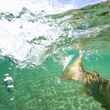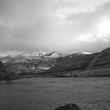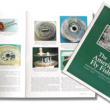As spring rains in the Rockies push lowland creeks and streams out of their grassy banks and stain the water just a bit, smart anglers will disregard the disdain many fly fishers hold for a particular fly pattern and they’ll happily catch trout, because this fly does, indeed, match the hatch.
Aquatic worms dwell in the moist and muddy banks along bottomland springs and streams, and when water rises, these worms—not unlike the ones you used to dig up in grandma’s garden before heading off to fish as a kid—end up in the water. And the trout love them.
For the fly angler, the tried-and-true San Juan worm is a great springtime searching pattern, and fished Czech style or under an indicator, it can liven up any April or May fishing trip to any number of the West’s great trout waters (and those secret desert streams that fish well this time of year, particularly after spring rains). On a recent trip to southwest Montana’s Beaverhead River, with water up into the willows in some spots, the worm drifted deep under an indicator coaxed several fat browns to hand. In a little spring creek that flows out of Idaho’s Beaverhead Mountains just south of the border with Montana, my kids and I played with dozens of feisty rainbows one recent weekend, all thanks to the worm. My son, who prefers the simplicity of Tenkara, had great luck with the worm, high-sticking it through deep runs and plucking fish from the stream, seemingly at will.
The point is, the worm works. It’s reputation as one step above bait is undeserved, and, tied correctly, the fly will produce when most others won’t under high-water conditions. Think about it. For a trout, this critter offers a fat bite of protein that requires very little exertion to ingest. These worms, often waterlogged or even dead, are immobile in the water and don’t require much in the way of pursuit. They drift in the current and, especially after a rain or a high-water event on a tailwater, provide a stable buffet for trout.
Despite their natural presence, and the fact that the San Juan worm is a reasonable imitation of red worms and other aquatic worms, or even leaf worms, for that matter, the fly itself is often frowned upon by fly fishers who consider its use a bit less than savory. Originally tied to imitate the small worms in the substrate of New Mexico’s San Juan River, a tailwater fishery with frequent changes in water levels thanks to irrigation needs downstream, the fly has spurred something of a cult following. Most won’t tie it on at the car when they’re gearing up with fishing buddies, but when fishing proves slow, you can bet the worm converts are among the first to step over to the dark side.
But it’s not a dark side. It’s no different than tying on a size 16 tan caddis, or a fat size 8 salmonfly imitation if that’s what happens to be on the water. The worm is a hatch-matcher, and it’s time the shame associated with its use subside.
I’ve used the worm periodically after rains or during high water for years—a guide on Colorado’s Gunnison River explained to me, as we took a sleigh-ride through the run-off-swollen Gunnison Gorge one blustery May afternoon, that, fished tight to the banks, the worm would be what pulls big browns out from under cutbanks to eat. Sure enough, along a lazy bend in the coffee-and-cream colored river, a fat 22-inch brown pulled my indicator deep and then bulled its way into the current for an epic fight. A few minutes later, after beaching the boat and bringing the fish to hand, the guide was quick to remove the fly from the big fish’s maw before he let me pose for a photo.
“You don’t want the world to know what just happened, do you?” he asked me.
To make the conversion to full-on dirtbag fly fisher a bit easier, know that the worm is an easy tie at the vise. Get your hands on some red, light brown, purple and even pink vermille and some thread to match, and you’re all set. Some light it up a bit with wire ribbing—I’ll put a brass bead over the vermille and let it “float” away from the hook—just to give it a bit of sparkle in dark water and a bit of weight. Honestly, though, a simple inch-long strip of vermille is generally all you need. Wrap it tight to your average nymph hook, and you’re ready to fish.
I thought about what the guide asked me that day on the Gunnison, and then I agreed that this event would be “our little secret.” Over time, I’ve revisited this approach, and I’ve come to the conclusion that nothing untoward happened on the river that gray day in central Colorado.
The secret’s out. The worm is legit, and if you’re too damned proud to dive to the depths of the fly box for the right pattern for the conditions, that’s on you. The rest of us … well, we’ll catch a few trout for you.
And when you ask what they’re hitting on, we’ll just shrug and say, “I”m just matching the hatch.”

































Comments
Tom Poremba replied on Permalink
SJ worms work great in Pennsylvania as well.....And it has been raining for over a week here....
Darin Crew replied on Permalink
Just use the worm after much needed rains on a solid Pocono River- caught some big fish- under an indicator at the righr depth. I bet a streamer might have worked to but- there was no chance for much else. Even nymphs would have been hard to see. Thanks
Chris Stewart replied on Permalink
Chris, I agree with your sentiments except for two things. I tie 'em on at the car and I tell people I use 'em. Then I show them a no vise, no thread worm pattern they can tie streamside, give them some chenille and make another convert.
Dean B. Cade replied on Permalink
Can't do the dirty, bait fishin, zero aesthetics, snobbery guilty!
Derek replied on Permalink
Never got the whole "it's not a fly" thing. What the hell is a zebra midge? Nothing but thread and wire. How is that "better" than thread and chenille, or thread and a little latex noodle? Annelids are everywhere. If you pay attention, you can even find them in the stream when there isn't a rainstorm. So can the fish.
On second thought... the naysayers are right. It's not a fly. Nobody should use it...
Bob Krumm replied on Permalink
Chris: Aquatic worms live in the streams proper usually associated mossy cobblestone. We find them all over the Bighorn River in Montana.
Pages